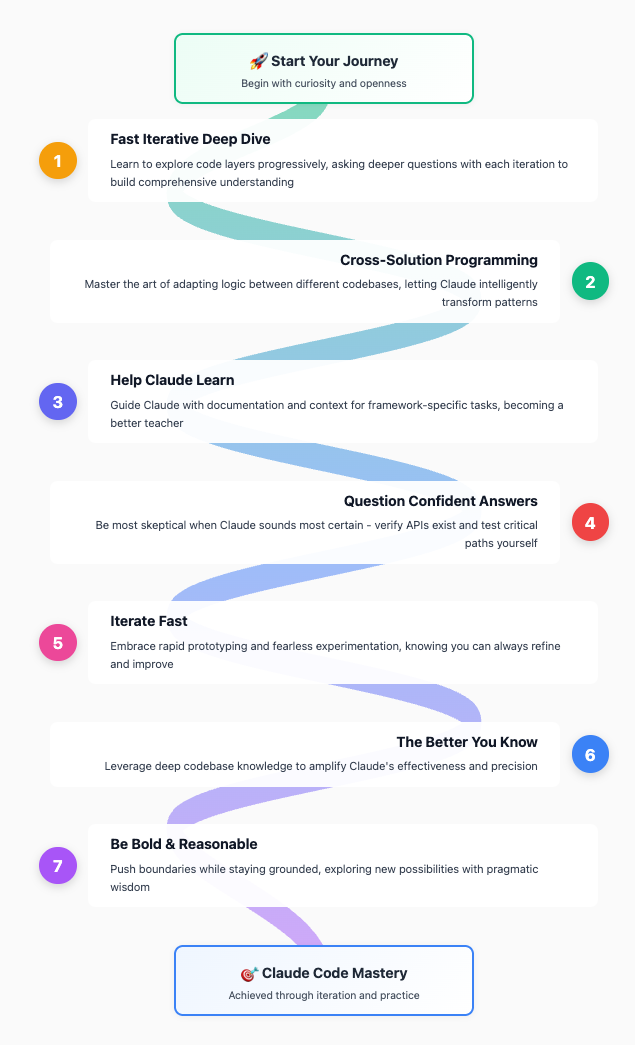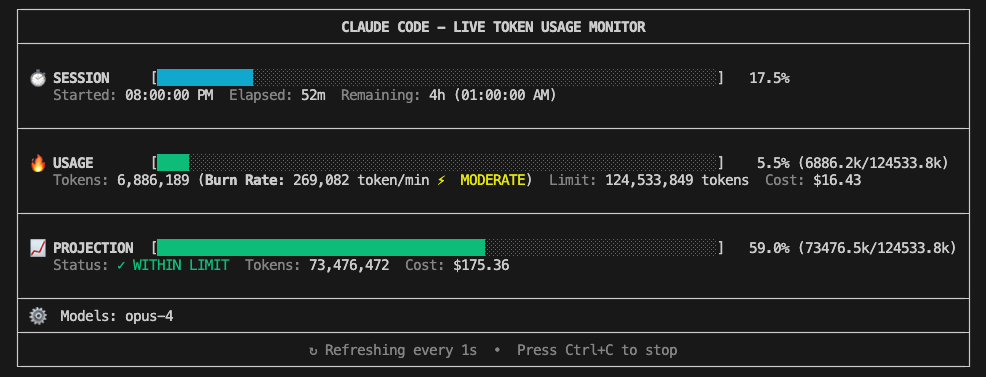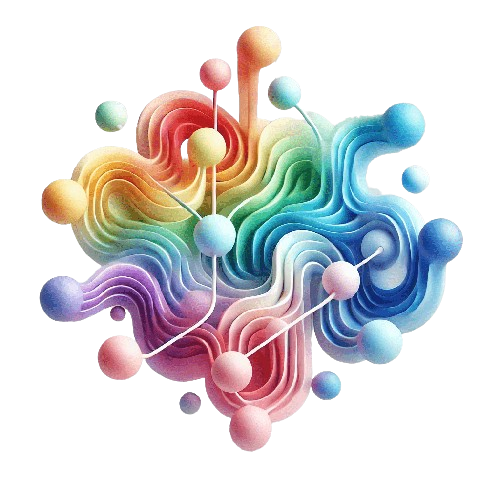In this third post about Claude Code, I want to share the techniques that have transformed my development workflow. After months of daily use, I’ve discovered seven powerful strategies that consistently deliver results. These aren’t theoretical concepts - they’re practical techniques I use every day to write better code faster, explore unfamiliar codebases with confidence, and push the boundaries of what’s possible with AI-assisted development.
The common thread weaving through all these techniques is iteration - not just in Plan Mode (which I covered in my Field Notes), but as a fundamental philosophy for every interaction with Claude Code. Whether you’re diving deep into code, bridging solutions, or managing context, the iterative approach transforms Claude from a simple code generator into a true collaborative partner. Each cycle of interaction refines your understanding, improves the output, and builds toward better solutions.

Table of Contents
- Technique 1: Fast Iterative Deep Dive
- Technique 2: Cross-Solution Programming
- Technique 3: Help Claude Code Learn
- Technique 4: Question Confident Answers
- Technique 5: Master Your Model Management
- Technique 6: The Better You Know
- Technique 7: Be Bold & Reasonable
- Conclusion
Technique 1: Fast Iterative Deep Dive
Writing code is great, but I tend to forget all the details about what I have already written. Claude Code is a great assistant here, especially when you remember some part of the implementation and can formulate your prompt.
The power lies in the iterative exploration cycle: you ask an initial question, Claude explores and responds, you refine your understanding and ask deeper questions, Claude dives further. Each iteration peels back another layer of complexity, building a progressively deeper understanding. It’s like having a conversation with the codebase itself.
It is also great for quickly understanding new code or even analyzing packages that are used and installed anywhere, e.g. in node_modules. Just ask Claude Code for further details on a specific implementation or file, there is no faster way to foster and understand a new code base, especially when it is quite large.
Technique 2: Cross-Solution Programming
Let’s say you have one solution where a specific logic is implemented and want to implement the “same” feature in another solution. This works very well in Claude Code, and it doesn’t need to be replicated one-to-one - Claude can adapt it to the target solution:
- First, start in the solution where the logic is implemented
- Ask Claude Code to analyze a specific implementation
- Then ask Claude Code to implement this in the target solution and pass the target folder path. Claude Code will ask for permissions to write there and adapt the solution to the target solution.
Please do not forget:
- Use CLAUDE.md for both solutions
- Use “Plan Mode” and iterate as long as the plan isn’t perfect
Technique 3: Help Claude Code Learn
I found out that in some areas, Claude Code was not aware of specific technical implementation frameworks. Instructing Claude Code to use a specific documentation page from the internet was very helpful in these cases.
Note: This may change with an MCP Server like Context7 which I may explore, but I don’t have enough experience with it at the moment.
Technique 4: Question Confident Answers
One of the most critical skills in working with Claude Code is knowing when to be skeptical. Claude can sound incredibly confident while being completely wrong. This is especially dangerous when it affirms something with certainty - “Yes, this will work” or “This is the correct approach” - because its confidence level doesn’t correlate with accuracy.
I’ve learned to be most vigilant when Claude:
- Confidently claims a library or API exists
- Says “just use this function” without verifying it’s real
- Affirms that something complex will “definitely work”
- Provides specific version numbers or configuration details from memory
The solution? Always verify critical paths yourself. Test the code. Check that the APIs actually exist. When Claude sounds most certain, that’s often when you need to be most careful. This skepticism isn’t about distrusting Claude - it’s about understanding that LLMs can hallucinate plausible-sounding solutions. The more specific and technical Claude’s answer, the more important it is to verify.
This critical thinking saves hours of debugging phantom solutions and makes you a true master of AI-assisted development.
Technique 5: Master Your Model Management
Working effectively with Claude Code requires understanding its model system and managing your usage strategically. After months of intensive use, I’ve learned that model awareness is crucial for sustained productivity.
Understanding the Model Options
Claude Code offers two models, each with different capabilities and cost implications. You need to be aware of your /model setup because you will inevitably reach limits, especially with Opus.

The reality of working with Claude Code is that you’ll likely hit the Opus limit during intensive coding sessions:

Track Your Usage with ccusage
To manage your model usage effectively, I highly recommend the ccusage tool by ryoppippi. This invaluable utility helps you monitor your Claude API consumption in real-time and provides detailed statistics about your daily usage patterns.
With ccusage, you can track your model usage and even get live statistics during active coding sessions using ccusage blocks --live. This visibility into your usage patterns helps you make informed decisions about when to use which model.

Note: The costs shown by ccusage are estimated based on API pricing and do not reflect the actual costs you pay with a Claude subscription, which may absorb all those usage costs.
Strategic Model Usage
Understanding your limits allows for strategic model usage:
- Start with Sonnet for most coding tasks - it’s capable and efficient
- Reserve Opus for complex architectural decisions and challenging debugging
- Monitor usage regularly to avoid unexpected interruptions during critical work
This awareness transforms Claude Code from a simple coding assistant into a resource you can strategically manage for maximum productivity over time.
Technique 6: The Better You Know
The best results I have achieved with Claude Code - and it’s no surprise - is when I was very familiar with the structure and the codebase and could point Claude Code to the exact place and describe how I wanted the implementation. So knowing your codebase well is the best starting point to leverage the maximum out of Claude Code.
Technique 7: Be Bold & Reasonable
Finally, Claude Code enables new possibilities, whether in the speed of implementing new functionalities or enabling you to use it in environments or programming languages you don’t know. So be bold - Claude Code will be very supportive. Sometimes too supportive, which may lead to something impossible to implement, so be reasonable.
Conclusion
These seven techniques have fundamentally changed how I approach software development. Claude Code isn’t just a tool that writes code - it’s a collaborative partner that amplifies your capabilities in ways I never imagined possible.
The key insight? The more intentional you are with Claude Code, the more powerful it becomes. Whether you’re diving deep into forgotten code, bridging solutions, or boldly experimenting with new technologies, these techniques will help you work smarter, not harder.
But above all, embrace iteration. Every interaction with Claude Code is an opportunity to refine, improve, and discover. The iterative philosophy isn’t just about fixing mistakes - it’s about progressively building toward excellence, one cycle at a time. Each technique becomes more powerful when you apply it iteratively, allowing both you and Claude to learn and adapt together.
Remember: Claude Code is as effective as the developer using it. Master these techniques, understand your codebase, manage your context wisely, and don’t be afraid to push boundaries while staying grounded in what’s achievable.


